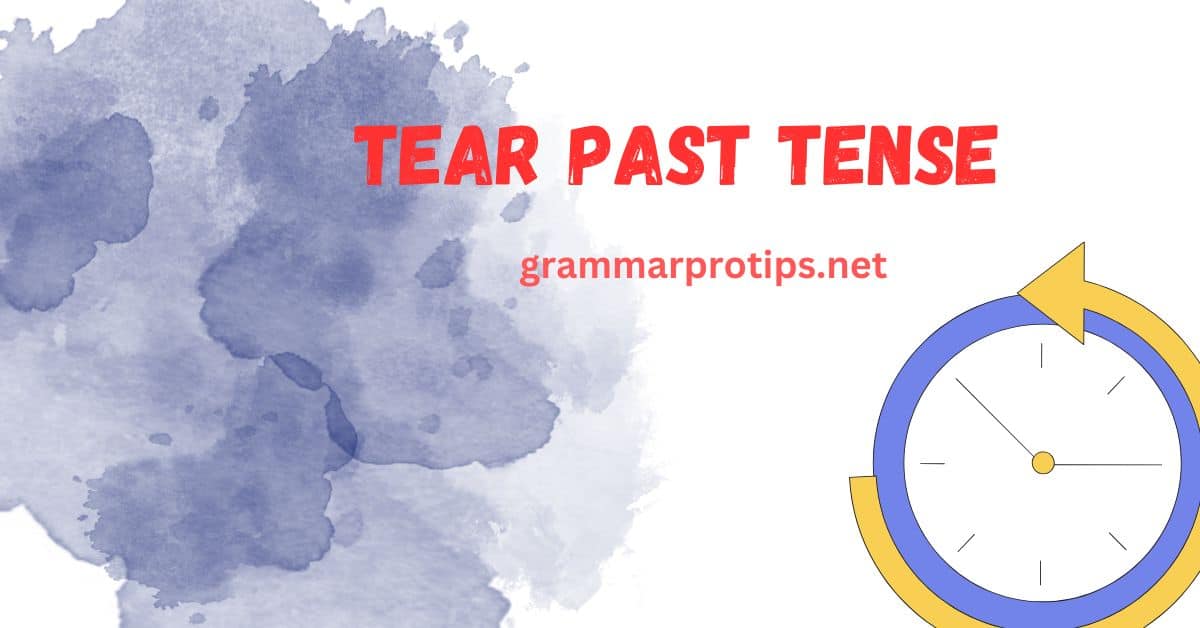The English language can sometimes be confusing, especially when it comes to verb forms and tenses. A perfect example of this confusion is the past tense of the verb tear. You’ve probably seen the words tore, teared, and torn used interchangeably, but which one is actually correct?
Let’s dive into the different forms of the verb tear, examine their meanings, and clear up any confusion surrounding tear past tense.
Understanding the Different Forms of Tear
Before we get into the specifics of the past tense, let’s first take a look at the basic verb forms of tear. These include:
- Tear (present tense)
- Tore (simple past)
- Torn (past participle)
You may also encounter teared, but this form is actually less common and often considered incorrect in many contexts. Let’s break down the past tense of tear and other verb forms more thoroughly.
Tear: The Present Tense
In its present tense form, tear typically means to rip or pull apart something. It can also refer to the action of shedding tears as a result of emotion, such as crying. For example:
- I tear the paper every time I try to fold it. (ripping)
- She tears up when she talks about her childhood. (crying)
Tore: The Simple Past Tense
When using the simple past tense of tear, you should use tore. This form is used when describing an action that occurred and was completed in the past. Here’s an example of how to use tore in context:
- Yesterday, I tore the envelope open to see if the letter had arrived.
In this sentence, the act of tearing happened in the past, and it was completed.
Example in a Scenario:
Imagine sending an email to a friend about an old incident:
“I remember last week, when I tore the fabric on my jacket while trying to fix it. I was so upset!”
The verb tore fits perfectly here to describe an action completed in the past.
Torn: The Past Participle
The past participle of tear is torn, and it’s used when forming perfect tenses or the passive voice. The past participle is often paired with auxiliary verbs like have, has, or had. For example:
- I have torn the letter into pieces.
- She had torn the fabric before she noticed the damage.
- By the time we arrived, the envelope had already been torn open.
Teared: Is This Correct?
While teared does exist, it’s mostly used in the context of crying—not in the context of ripping or tearing something physically. So, you might say, “She teared up during the movie,” but when referring to ripping something, teared is not commonly used. The correct form for ripping or tearing objects is tore or torn, not teared.
Example of Teared in Context (Crying):
- “After hearing the news, he teared up and couldn’t stop crying.”
- “She teared up when she saw the photo of her grandmother.”
How to Use the Past Tense of Tear: Scenarios

Tear Past Tense Sentence Example 1: Tore
Let’s say you’re writing a message to a colleague explaining how you accidentally tore some paperwork:
- “I accidentally tore the document while trying to staple it. I’ll get a new one sent to you right away.”
This is a simple past tense example of how tore works in a sentence.
Tear Past Tense Sentence Example 2: Torn
Now, imagine you’re speaking to someone about an object that is in a damaged state, and you’re talking about the past action of it being torn:
- “The letter was already torn when I found it in the mailbox. I’m not sure what happened to it.”
In this case, torn is used as a past participle to describe the state of the letter after it was torn.
How Tense Affects the Meaning of Tear
The meaning of tear can change depending on the tense and context. Let’s explore the various tense forms of tear and how they affect the meaning.
Tear Past Tense Meaning
The past tense of tear refers to something that was ripped, damaged, or destroyed in the past. It could refer to the physical act of tearing something or the emotional act of crying. Understanding which form to use in different scenarios is crucial to communicating clearly.
- Simple past tense (tore): Refers to an action that has already happened.
- Past participle (torn): Describes the result of an action in perfect tenses.
Tear, Tore, Torn Meaning in Context
The verb tear is flexible in meaning and usage. Tear could refer to physically ripping something (like paper), shredding an item, or even lacerating an object. Alternatively, it can refer to crying and the emotional response that leads to weeping.
Example of Emotional Meaning: Tear (Crying)
- “She shed tears at her graduation because she was overwhelmed with emotion.”
- “Tears streamed down his face as he read the heartfelt letter from his childhood friend.”
Here, tears represent the fluid drop that comes from one’s eyes during emotional moments, illustrating the more figurative meaning of tear.
Verb Usage and Tense Forms: The Confusion
Understanding verb usage in English is key to mastering verb forms. The confusion around the past tense of tear often comes from its two different meanings: physical tearing (like ripping paper) and emotional tearing (as in crying). However, tore and torn are used in similar ways to describe both actions.
- Tear (verb): To rip or to cause something to break apart.
- Tore (simple past): Refers to the action of ripping or tearing something in the past.
- Torn (past participle): Describes something that has been torn, or the state resulting from an action of tearing.
Tear in Different Tenses: Future, Present, and Past Perfect
When forming different tenses, you’ll notice that tear changes its form to match the tense you’re working with. Let’s look at how the verb forms of tear function across several tenses:
- Present tense (tear): “I tear the paper every time I try to fold it.”
- Past tense (tore): “I tore the paper last night while wrapping a gift.”
- Past participle (torn): “The paper has been torn into pieces.”
- Future tense (tear): “I will tear the letter open when I get home.”
- Past perfect tense (torn): “By the time I arrived, the paper had already been torn.”
Tear Verb Forms V1 V2 V3
The verb forms of tear follow this pattern:
- V1 (present tense): Tear
- V2 (simple past): Tore
- V3 (past participle): Torn
In some instances, the verb may be used in both its transitive and intransitive forms. For example, tear can be used with an object (transitive) or without an object (intransitive).
- Transitive: “I tear the paper.”
- Intransitive: “The paper tears easily.”
Pronunciation of Tear
It’s also essential to note that tear (meaning to rip something) is pronounced differently from tear (the noun for a drop of fluid from the eye). The pronunciation of the verb tear (to rip) is /tɛər/, while the noun tear (fluid drop) is pronounced /tɪər/.
Common Mistakes: Past Tense Confusion
One of the most common mistakes people make when talking about the past tense of tear is using teared in contexts where tore or torn should be used. Remember, teared is typically reserved for emotional crying, not for ripping something apart.
Example of Mistake:
Incorrect: “I teared the paper in half last night.”
Correct: “I tore the paper in half last night.”
Conclusion: Which Form Should You Use?
To sum up, here’s a quick reference guide to help you choose the right form of tear in different contexts:
- Use tear in the present tense.
- Use tore when talking about something that happened in the past.
- Use torn when describing the result of an action (past participle).
By understanding the difference between these forms and using them correctly, you can avoid language confusion and sound more fluent in your writing and speaking.
So next time you’re wondering whether to use tore or torn, remember the tense you’re working with and keep it simple. Whether you’re ripping a piece of paper or shedding tears in grief, knowing the correct form of tear will help you communicate with precision.

Sienna Mauldon is a passionate writer and grammar expert. On her blog, she shares easy-to-follow guides to help readers master grammar rules and improve their writing. With a love for language and teaching, Sienna makes grammar simple and fun for everyone, from beginners to experienced writers.








